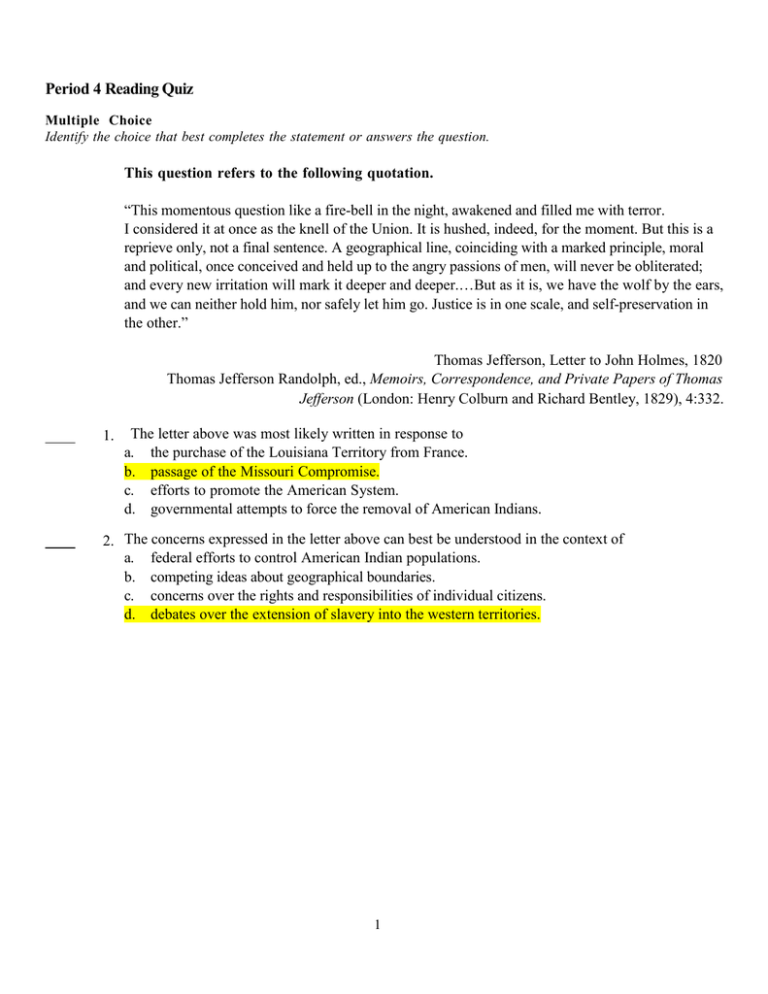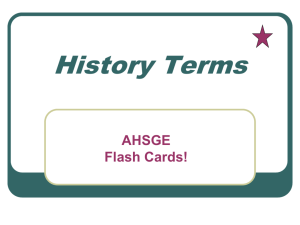Period 4 Reading Quiz
advertisement

Period 4 Reading Quiz Multiple Choice Identify the choice that best completes the statement or answers the question. This question refers to the following quotation. “This momentous question like a fire-bell in the night, awakened and filled me with terror. I considered it at once as the knell of the Union. It is hushed, indeed, for the moment. But this is a reprieve only, not a final sentence. A geographical line, coinciding with a marked principle, moral and political, once conceived and held up to the angry passions of men, will never be obliterated; and every new irritation will mark it deeper and deeper.…But as it is, we have the wolf by the ears, and we can neither hold him, nor safely let him go. Justice is in one scale, and self-preservation in the other.” Thomas Jefferson, Letter to John Holmes, 1820 Thomas Jefferson Randolph, ed., Memoirs, Correspondence, and Private Papers of Thomas Jefferson (London: Henry Colburn and Richard Bentley, 1829), 4:332. 1. The letter above was most likely written in response to a. the purchase of the Louisiana Territory from France. b. passage of the Missouri Compromise. c. efforts to promote the American System. d. governmental attempts to force the removal of American Indians. 2. The concerns expressed in the letter above can best be understood in the context of a. federal efforts to control American Indian populations. b. competing ideas about geographical boundaries. c. concerns over the rights and responsibilities of individual citizens. d. debates over the extension of slavery into the western territories. 1 This question refers to the following quotation. “Every one acquainted with southern slaves knows that the slave rejoices in the elevation and prosperity of his master; and the heart of no one is more gladdened at the successful debut of young master or miss on the great theatre of the world than that of either the young slave who has grown up with them and shared in all their sports, and even partaken of all their delicacies—or the aged one who has looked on and watched them from birth to manhood, with the kindness and most affectionate solicitude, and has ever met from them all the kind treatment and generous sympathies of feeling, tender hearts. Judge Smith…said in an emergency he would rely upon his own slaves for his defence—he would put arms into their hands, and he had no doubt they would defend him faithfully. In the late Southampton insurrection, we know that many actually convened their slaves and armed them for defence, although slaves were here the cause of the evil which was to be repelled.” Thomas Dew, President of the College of William and Mary, 1832 William Harper, James Henry Hammond, William Gilmore Simms, and Thomas Roderick Dew, The Pro-Slavery Argument (Philadelphia: Lippincott, Grambo, 1853), 457–58. 3. The author’s sentiments in the excerpt above can best be understood as a. supportive of the continuation of the international slave trade. b. opposition to the continued restrictions against citizenship for slaves. c. an expression of Southern pride in the institution of slavery. d. an argument for the gradual emancipation of slaves. 4. The excerpt above was most likely a response to which of the following? a. The outlawing of the international slave trade b. The abolitionist criticism of the treatment of slaves in the South c. The creation of free African American communities d. The formation of a temporary national truce over the issue of slave 2 3 This question refers to the following quotation. “If any one proposition could command the universal assent of mankind, we might expect it would be this: that the government of the Union, though limited in its powers, is supreme within its sphere of action. This would seem to result necessarily from its nature. It is the government of all; its powers are delegated by all; it represents all, and acts for all. Though any one State may be willing to control its operations, no State is willing to allow others to control them. The nation, on those subjects on which it can act, must necessarily bind its component parts.… Although, among the enumerated powers of government, we do not find the word ‘bank’ or ‘incorporation,’ we find the great powers to lay and collect taxes; to borrow money; to regulate commerce; to declare and conduct a war; and to raise and support armies and navies…a government, intrusted with such ample powers…must also be instructed with ample means for their execution.…We are unanimously of opinion, that the law passed by the legislature of Maryland, imposing a tax on the Bank of the United States, is unconstitutional and void.” Chief Justice John Marshall, McCullough v. Maryland, 1819 5. Which of the following did NOT result from the Supreme Court ruling above or similar rulings by the Supreme Court in the early 1800s? a. The recognition of federal power over state laws b. The promotion of regional interests over national concerns c. The assertion of the primacy of the judiciary d. The Court determining the meaning of the Constitution 6. The ideas expressed in the excerpt above can best be understood in the context of debates over a. the authority of different branches of the federal government. b. the scope of the federal government’s role in the economy. c. the relationship between the federal government and state governments. d. how to match democratic political ideals to political institutions. 4 This question is based on the following map. U.S. Roads and Canals, 1837 Nancy A. Hewitt and Steven F. Lawson, Exploring American Histories, Bedford/St. Martin's, p. 266. Reprinted by permission. 7. The expansion of the U.S. transportation network by 1837, as shown in the map above, benefitted MOST from which of the following technological advances? a. Interchangeable parts b. Textile machinery c. The steam engine d. The telegraph 5 8. As shown in the map above, the national system of roads and canals most closely linked which regions’ economies together? a. The North and the South b. The East and the Midwest c. The Midwest and the South d. The North, Midwest, and South equally 9. The opening of canals and new roads in the United States, as depicted in the map above, had the LEAST impact on which of the following? a. European immigration to the United States b. Westward migration of American citizens c. The market revolution d. Regional economic specialization This question refers to the maps below. Map of Slave Populations in 1820 and 1860 Nancy A. Hewitt and Steven F. Lawson, Exploring American Histories, Bedford/St. Martin's, p. 298. Reprinted by permission. 1 10. What contributed most to the process illustrated in the maps above? a. The Missouri Compromise of 1820 b. The outlawing of the international slave trade c. The overcultivation of arable land in the Southeast d. The rise in the number of free African Americans in the South 11. The maps above most clearly demonstrate which of the following antebellum-era historical processes? a. The acceleration of a national and international market economy b. The free and forced migration of peoples across the continent c. The rise of abolitionist and other voluntary reform organizations d. The attempts of the United States to dominate the North American continent 2



